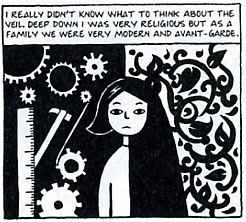Hello all!
Recently in my class, we’ve been going over an essay of Persepolis: A Story of a Childhood (by Marjane Satrapi) written by the feminist Hillary Chute. The essay, The Texture of Retracing in Marjane Satrapi’s Persepolis, was insightful, and had a very deep analysis of Persepolis.
For example, the use of black backgrounds in Persepolis. Originally, I had thought that the blackness was a way for Satrapi to help set the mood of the panel, and add to what was already drawn in the panel. Black backgrounds to match or create heavy and dark moods, essentially. However, Chute argues that the black backgrounds show readers the process of remembering, and represents the ‘thickness’ or ‘depth’ of the memory (pg 98). Citing Kate Flint, a scholar of art history and english, Chute suggests that the emptiness of black backdrops invites the mind to project memories onto the space. Thus, the practice of remembering is carried out by the author, and maybe even the reader.

Persepolis by Marjane Satrapi, pg 6
Reading Chute’s essay also revealed to me some things that I had not know about Persepolis before. I had not known that Satrapi’s drawing style reflects ancient Persian murals, miniatures, and friezes! That fact helped me with my speculations on Satrapi’s drawing style. I had first thought that Satrapi’s drawing style was meant to represent the perspective of a child (Marji), but knowing that style resembled old Persian ones shed some light on the purpose for the way Satrapi drew Persepolis. Persepolis is a story of a child growing up in Iran, Satrapi references this Iranian heritage multiple times. The book’s title itself, Persepolis, an ancient and ruined Persian city. The history of Iran, from ancient times to the 20th Century is spoken of multiple times in the book. And now, Satrapi’s drawing style itself!
It was incredibly interesting to find out, and makes me wonder what other references Satrapi had made. I realise that, due to my own lack of knowledge of Iranian culture, I would have missed such connections. It makes me wonder if one of the reasons Satrapi makes all these references is for the purpose of encouraging readers to find out more of Iranian culture.
I personally love discovering references, and find that it makes me enjoy and relate to the story more. I’ve also found that references make good incentive to search for information to explain references that I find, but do not have enough knowledge of to appreciate it. Could the references Satrapi makes actually be used to encourage readers to find things out? To seek more information about Iran and the culture that surrounds it?
I believe that it could.